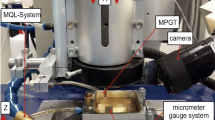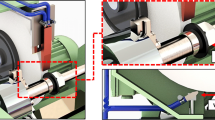Abstract
This paper discusses the performance of the minimum quantity lubrication (MQL) in micro-grinding based on ground surface roughness and tool life. The effects of grinding and lubricating parameters on machining performance are studied. Experiments for dry grinding and grinding with pure air are also conducted for comparison. It is observed that surface roughness and tool life are improved with the application of MQL in micro-grinding. Experimental results show that efficient chip removal from the cutting zone in micro-grinding is important for achieving good surface finish and adequate tool life. The application of a small amount of cutting oil in MQL can significantly extend the tool life. In this study, the tool life in MQL is seven times longer than that in dry grinding and five times longer than that in grinding with air cooling. If the oil flow is surplus to requirements or the air flow is inadequate, excess oil will stay on the grinding tool after the grinding test. As a result, poor surface roughness is observed. The optimal lubrication conditions in this experimental exploration are the combination of an oil flow of 1.88 ml/h and an air flow of 25 L/min.
Similar content being viewed by others
References
Boothroyd G, Knight WA (1989) Fundamentals of machining and machine tools, 2nd edn. M. Dekker, New York
Weinert K, Inasaki I, Sutherland JW, Wakabayashi T (2004) Dry machining and minimum quantity lubrication. Ann CIRP 53(2):511–537
Klocke F, Eisenblaetter G (1997) Dry cutting. Ann CIRP 46(2):519–526
Brockhoff T, Walter A (1998) Fluid minimization in cutting and grinding. Abrasives 38–42
Wang ZG, Rahman M, Wong YS, Neo KS, Sun J, Tan CH, Onozuka H (2009) Study on orthogonal turning of titanium alloys with different coolant supply strategies. Int J Adv Manuf Technol 42(7–8):621–632
Rahman M, Kumar AS, Salam MU (2001) Evaluation of minimal quantities of lubricant in end milling. Int J Adv Manuf Technol 18(4):235–241
Li K-M, Liang SY (2007) Performance profiling of minimum quantity lubrication in machining. Int J Adv Manuf Technol 35(3–4):226–233
Thakur DG, Ramamoorthy B, Vijayaraghavan L (2010) Investigation and optimization of lubrication parameters in high speed turning of superalloy Inconel 718. Int J Adv Manuf Technol 50(5–8):471–478
Ueda T, Hosokawa A, Yamada K (2006) Effect of oil mist on tool temperature in cutting. J Manuf Sci Eng, Trans ASME 128(1):130–135
Hafenbraedl D, Malkin S (2000) Environmentally conscious minimum quantity lubrication (MQL) for internal cylindrical grinding. NAMRC XXVIII, Lexington, Kuntucky
Silva LR, Bianchi EC, Fusse RY, Catai RE, Franca TV, Aguiar PR (2007) Analysis of surface integrity for minimum quantity lubricant-MQL in grinding. Int J Mach Tool Manuf 47(2):412–418
Shen B, Shih AJ, Tung SC (2008) Application of nanofluids in minimum quantity lubrication grinding. Tribol Trans 51(6):730–737
Alves JAC, Fernandes UB, Silva Junior CE, Bianchi EC, Aguiar PR, Silva EJ (2009) Application of the minimum quantity lubrication (MQL) technique in the plunge cylindrical grinding operation. J Braz Soc Mech Sci Eng 31(1):1–4
Tawakoli T, Hadad MJ, Sadeghi MH, Daneshi A, Stockert S, Rasifard A (2009) An experimental investigation of the effects of workpiece and grinding parameters on minimum quantity lubrication-MQL grinding. Int J Mach Tool Manuf 49(12–13):924–932
Sadeghi MH, Haddad MJ, Tawakoli T, Emami M (2009) Minimal quantity lubrication-MQL in grinding of Ti-6Al-4V titanium alloy. Int J Adv Manuf Technol 44(5–6):487–500
Friedrich CR (2000) Near-cryogenic machining of polymethyl methacrylate for micromilling tool development. Mater Manuf Process 15(5):667–678
Jun MBG, Joshi SS, DeVor RE, Kapoor SG (2008) An experimental evaluation of an atomization-based cutting fluid application system for micromachining. J Manuf Sci Eng, Trans ASME 130(3):0311181–0311188
Lopez de Lacalle LN, Angulo C, Lamikiz A, Sanchez JA (2006) Experimental and numerical investigation of the effect of spray cutting fluids in high speed milling. J Mater Process Technol 172(1):11–15
Author information
Authors and Affiliations
Corresponding author
Rights and permissions
About this article
Cite this article
Li, KM., Lin, CP. Study on minimum quantity lubrication in micro-grinding. Int J Adv Manuf Technol 62, 99–105 (2012). https://doi.org/10.1007/s00170-011-3789-1
Received:
Accepted:
Published:
Issue Date:
DOI: https://doi.org/10.1007/s00170-011-3789-1




